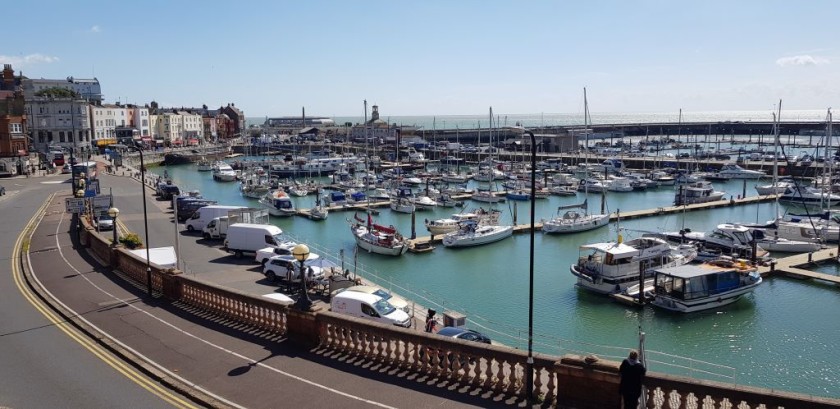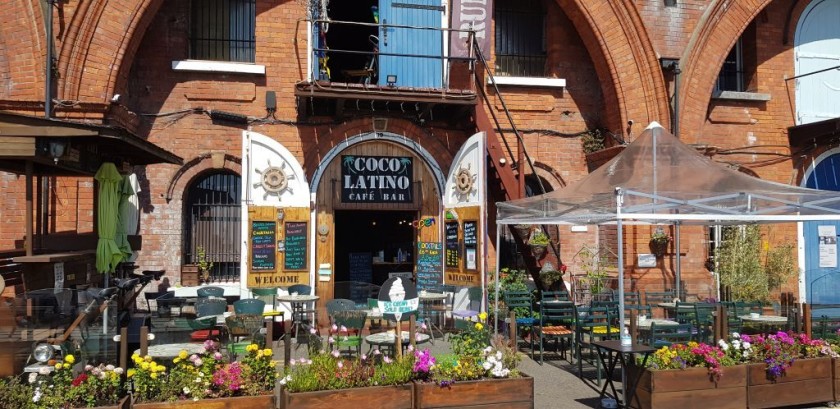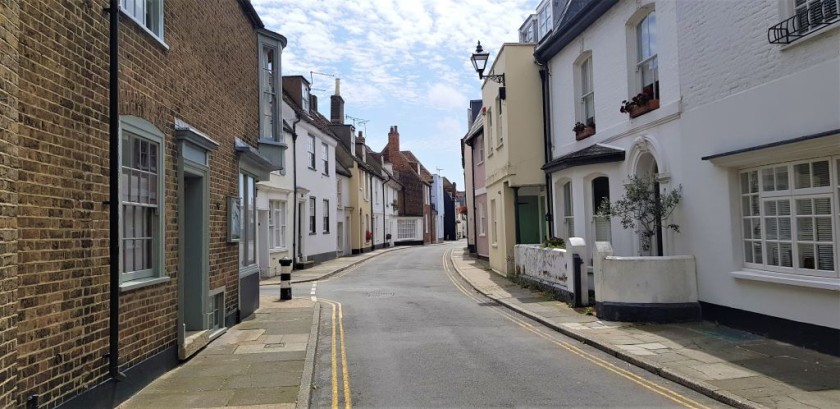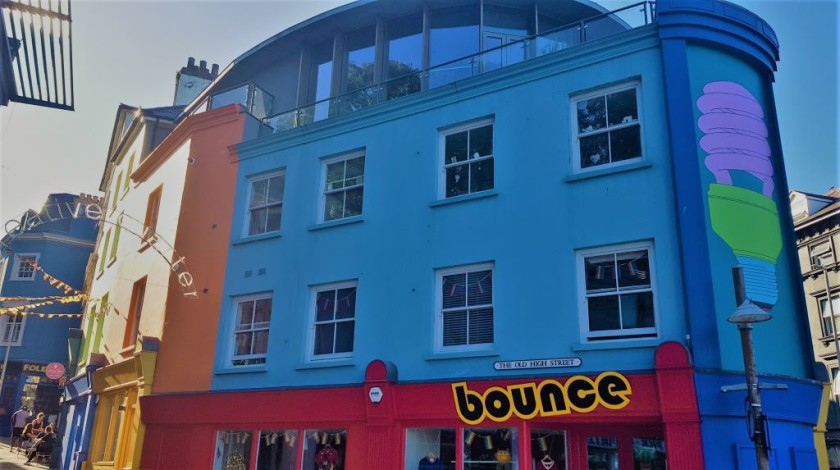Related Content
Content

Explore the Kent coast by train
Have a fabulous holiday, by exploring the many delightful locations on the Kent Coast, on easy train journeys.
Share

As Great Britain is an island it benefits from a plethora of beautiful coastal railway journeys including those in south Devon, between St Erth and St Ives, the Cambrian Coast route, the East Coast main line, the West Highland Line and many other routes in Scotland.
These railway routes are renowned partially because of the sea views that can be seen during the journey, but especially because of the images taken of the trains as they move along the coast, showcasing the travel in beautiful settings.
Though aside from a brief section of a journey between Folkestone and Dover, pictured above, where the railway is cut into the base of the infamous white cliffs, the railway which mirrors the coastline of Kent, lacks the necessary picturesque quality for film and TV use, or to create a buzz on Instagram.
Hence it's likely that the majority of those who live outside the county aren’t aware of this route, but what makes it so very special is that it's in effect a necklace strung with the jewels of a plethora of charming coastal towns.
Because the route connects Faversham → Whitstable → Herne Bay → Margate → Broadstairs → Ramsgate → Sandwich → Deal → Dover → Folkestone, so it's possible to make short hops by train between multiple locations, which are all ideal day trip by train destinations.
How to explore

One simple connection at Ramsgate is all that's required when travelling Whitstable, Margate, Broadstairs ↔ Sandwich, Deal and Folkestone by train
So spending an extended period of time in this part of the world can therefore be enhanced, by the comparatively short journeys by frequent trains, to any of the other towns by the sea.
You can make things easy by basing yourself for the duration of the holiday in one location and then use it as a base from which to explore by train; Broadstairs, Deal and Whitstable are all particularly idyllic locations for extended breaks.
You can be spontaneous as you wish in the choice of daily destinations, because the money-saving Day Return tickets don’t need to be booked in advance to obtain a cheaper rate.
Plus train operator Southeastern has a kids for a quid ticketing policy!
Getting to the Kent Coast by train is also simple because all of the suggested towns below have direct services from London St Pancras International.
Plus there also trains from Victoria to Whitstable, Margate and Ramsgate; while Folkestone also has trains from Charing Cross, which call at Waterloo (East) and London Bridge.
Whitstable






Until around 30 years ago Whitstable was something of a hidden gem, it had been legendary for its oyster farming, but the trade had dwindled to near distinction, leaving the primary purpose of the town’s harbour as the delivery of raw materials to the tarmac plant, which had a less than idyllic aura.
However, the town’s link with oysters and their association to fine-dining, plus the proximity of its seafront to London, fueled a renaissance propelled by the opening of The Whitstable Oyster Company restaurant.
Great for craft shopping
People who indulge in fine-dining tend to have deep pockets, so the town has become a magnet for independent retailers, who were able to take advantage of an utterly charming high street.
Hence Whitstable became a shopper’s paradise for arts, crafts, ladieswear and the types of shops in which to purchase a unique gift, or travel memory.
The industrial character of the harbour has been softened by its use a location of a craft market and a food court; it is the place to come if you want to snack on the oysters.
Two beaches
The town also has two beaches which are a mix of shingle and sand, but they are both characterful. The beach to the west of the harbour is dominated by The Old Neptune pub, while that to the east of the harbour is backed by terraced rows of beach huts.
Though what makes Whitstable a special place is its atmosphere, as it isn’t so overly gentrified that it feels exclusive.
The town has retained its fish and chip restaurants, cafes and pubs that were established long before its discovery as a second-home paradise by the fashionistas of London.
So it’s a place where anyone can come and eat, drink and shop by the sea.
From the station
Whitstable station is at the opposite end of the town’s main street, from its harbour, the shortest route between the station and the harbour is by taking Cromwell Road, but the heart of the town is therefore a 15-20 min walk from the station.
An alternative is take the T (Triangle) bus service which connects Herne Bay station, where the bus stop is steps away from the station exit/entrance hall, to Whitstable town centre every 15-20mins.
Margate






The station in Margate is located across a road from a glorious sandy beach, but that aside, the exit from the station is an anti-climax, because the town’s revival in recent years has yet to reach the environs in which the trains come and go.
Boarded up tatty shops and a frankly hideous high-rise building, which dominate the area, don’t act as enticements to explore the town, but efforts to venture further along the sea-front are swiftly rewarded.
Because this is very much a location in which the first impressions when arriving by train can be quickly forgotten.
Spend time in Dreamland
All it takes is a minute's walk from the station, because steps away and opposite the beach, is the entrance to the wonderful Dreamland entertainment complex; home to a gorgeous amusement park with a retro-aura, a roller-skating rink an events venue, plus places to eat and drink.
On the other side of Dreamland are the scruffy sequence of ‘amusement arcades’ which had been the town’s chief attraction when it reached it’s nadir.
One of the UK's best showcases for modern art
But the beauty of Margate’s sandy bay, best viewed from its harbour, is timeless and it was a beloved location of arguably Britain’s most favored artist, JMW Turner.
Hence the opening of the Turner Contemporary gallery, which now dominates the town’s sea-front.
The Old Town
Intended as a landmark building to generate the town’s revival as a creative hub, it has also led to the complimentary benefit of transforming the immediate area.
The once neglected Marine Parade, a particularly fine example of early Victorian seaside architecture, which leads to the gallery, is now home to quality eateries, including a lovely ice-cream parlour and the very stylish Sands Hotel.
On the far side of Marine Parade, is a paved area at the sea end of Market Street, which on warm days fills with people enjoying the al-fresco dining services of multiple cafes and restaurants.
Market Street itself will take you into to the charming old town, which is the area in which Margate’s renaissance can be best appreciated.
It is home to a multitude of independent shops, many of which sell prints, paintings and other crafts, but it also houses multiple vintage stores, along with a plethora of other cafes and restaurants.
You don’t need to be interested in art to enjoy Margate, but what the influence of the gallery’s opening has achieved is to inject colour into the town. As well as being a hub for fun, Dreamland is a showcase for the best of retro-design and many of the town’s shops and eateries have embraced this theme.
And the beach is eternally wonderful, so Margate is very much a location where you can pick and choose what suits, though if it’s the shopping which most appeals, be aware that many of the establishments in the old town area, including most of the places to eat and drink, are closed on Mondays and Tuesdays.
Broadstairs


Despite’s it’s glorious Viking Bay, which so epitomizes the best of the English seaside that it was used as a location in the Landscape Artist Of The Year competition, Broadstairs was overshadowed by the larger towns of Margate and Ramsgate when UK seaside resorts had their heyday, in the-pre jetting off to the likes of Greece and Spain era.
This has been to the benefit of Broadstairs, as it hasn’t had to work so hard to overcome decline; a visitor who experienced the town in the 1950s would find it little altered today, which is of course the root of its charm.
For that reason Broadstairs makes a good base location in which to spend an extended period of time in order to see the rest of the Kent Coast by train.
It is close to being half way around the chain of lovely locations along the coast, plus it also has frequent trains to and from the historic beauty of Canterbury, for an alternative to days by the sea.
Of course Broadstairs isn’t frozen in time and its main shopping street is becoming home to multiple independent stores and places to eat/drink with a stylish aura, but the attractions of Morelli’s Gelato Parlour, and the terrace of The Royal Albion Hotel, both of which overlook the bay, are eternal.
Though for lovers of literary history the chief attraction of spending time in Broadstairs will be its association with Charles Dickens, as it is the location of Bleak House and is therefore home to a museum, which celebrates the author’s association with the town.
Arriving by train
The station in Broadstairs is located at the opposite end of the High Street to Viking Bay, but it is only a 12 -20 min walk from the sea-front.
Though be aware that the High Street is on a slight incline, but frequent buses link the station to the clifftop area which overlooks the bay.
Ramsgate




Because Ramsgate station is an interchange station with the railway which heads inland to Canterbury and is also, for the time being, where connections have to be made between trains when travelling Whitstable, Margate, Broadstairs ↔ Sandwich, Deal and Folkestone, at face value it seems like a good location for a holiday dedicated to exploring the Kent Coast by train.
However, the station’s location is some distance from the town’s sea front, so its surrounding area has a suburban aura, bereft of holiday accommodation.
Head to the harbour side
Though Ramsgate is very much worth a visit, with its chief attraction being its magnificent Royal Harbour, with its terraces that are home to multiple locations in which to have something to eat and drink while taking in the sea views.
The habourside, down by the boats, is also home to a plethora of places to eat.
The beach
Though for some the town’s most notable claim to fame is that it is where you will find Britain’s largest pub, The Royal Victoria Pavilion.
Behind the pub you’ll find a sandy beach, which is home to numerous rock pools when the tide is out.
The old town
If you visit the terraces by the harbour, don’t miss charming Addington Street, which was the town’s original main street in the Georgian era, and is the hub of the town’s historic quarter.
From this area head down Queen Street to the High Street, which has begun to attract independent retailers, in order to retrace your steps back to the station.
Sandwich




The charming town of Sandwich, which thanks to its one-time Earl’s penchant for eating meat between slices of bread, has leant its name to snacks enjoyed all over the world, isn’t by the coast, but for many the chief reason for heading here is the opportunity to take scenic boat trips which use the River Stour to access the sea.
Offshore there are numerous sandbanks which are home to colonies of seals and they can be seen on trips from Sandwich.
Though if you don’t want to visit the marine life, Sandwich is a delightful location in which to wander for a couple of hours, with a station that’s a level walk, within 10-15 mins of the town centre.
Deal


Of all the locations on this guide, only Margate has a station which is closer to the sea.
Halfway along the 10 min walk towards the beach, the road crosses the High Street, turn left and walk five minutes along it and you’ll come to what for many is Deal’s main attraction, it’s utterly lovely old town shopping quarter, which is also the location of a Saturday market.
It has an aura of ‘Hampstead sur la mer’ which is echoed by the maze of Georgian streets which lie between this section of the High Street and the beach.
If you can find somewhere to stay, the conveniently located charms of Deal make it a good base for an extended break, particularly if it’s the locations to south of Ramsgate, which have the most appeal.
A change of train at either Ramsgate or Dover, also provides Deal with easy access to the numerous delights of Canterbury.
On the seafront
By the water you can relax post-retail browsing, with something to eat or drink in The Royal Hotel, which is right on the beach, or head out to sea by dining in the Deal Pier Kitchen; though if you do choose to eat here, it’s best to head over directly from the station as it specializes in breakfast and lunch.
The castle
For those with an interest in military history a must-visit location is Deal Castle.
Folkestone






As you walk from Folkestone Central station towards the town centre along Cheriton Road, you’ll likely question why it’s including on this guide, but remain focused on your ultimate destination and your efforts will be rewarded.
As you enter the town centre and head towards its museum, you’ll still be wondering what you are doing here, but once you turn to the left on the other side of the museum, you’ll instantly see why Folkestone has been recommended.
There will a somewhat superfluous backboard in the middle of the street with ‘Welcome to the Creative Quarter’ written on it, but it will be obvious that you’ve reached your destination.
Off to the left the beguiling Old High Street will bend down on its path to the harbour; though the mobility compromised should be aware that this street is very steep.
Down to the harbour
Other towns on this guide also have charming old towns crammed with independent retailers specializing in crafts, vintage, fashion and gifts for the home, but what draws SMTJ to Folkestone like a moth to a flame is its unique harbour area.
Pre-Eurostar, the ‘railway’ route between Britain and France was to take boat-trains to Dover or Folkestone, from where cross-channel ferries departed for Calais and Boulogne.
The advent of the high-speed trains under the sea left the harbour and its station as abandoned wrecks, but in a remarkable restoration program, the station has been re-imagined as a pathway to the plethora of bars and restaurants on the quayside and the beach.
Though one not to be missed location in which to have a coffee or a sandwich is the café housed within the former railway signal box at the station.
Though for those who prefer the thrill of adventure sports over sea view dining, Folkestone is now home to Folkestone 51 skatepark.
To Dungeness by steam train


However, for those with a love of railways, Folkestone is worth a repeat visit.
Frequent buses on routes/lines 10A and 16 (Gold) take a spectacular coastal route from Folkestone Central station to Hythe, where they stop by the terminus station of the delightful Romney, Hythe and Dymchurch Railway.
It's wonderful miniature replicas of main line steam engines transport passengers to the unique location of Dungeness, which is the British landscape which most resembles a desert.
It offers a range of attractions from touring a nuclear power station to exploring a beloved artist’s unique garden.
Other locations in Britain, such as Devon, Cornwall and Pembrokeshire have multiple seaside gems, which aren't distant from each other, but the Kent Coast has been singled out because of the easy access available by train.
There isn't another railway line on the British Isles which serves so many locations that are ideal for coastal relaxation, so there is no need to bring a car to the Kent Coast, especially as the trains along the route are available every 30 mins daily!

Simon Harper
I wanted to share my passion for train travel and explain how anyone can take the fantastic journeys I have taken.

This is one of more than 100 train travel guides available on ShowMeTheJourney, which will make it easier to take the train journeys you want or need to make. As always, all images were captured on trips taken by ShowMeTheJourney.
This second version of ShowMeTheJourney is exciting and new, so we are genuinely thrilled that you are here and reading this, but we also need your help.
We’re striving not to let anything get in the way of providing the most useful service possible, hence a facility has been set up with DonorBox which can be used to support the running costs and make improvements.
Instead of advertising or paywalls, your financial support will make a positive difference to delivering an enhanced service, as there’s a lot of ideas which we want to make happen.
So if you have found the info provided here to be useful, please consider saying thank you.





